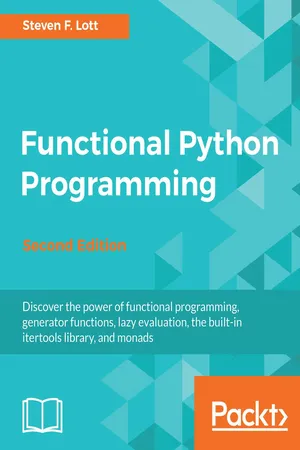
Functional Python Programming
Steven F. Lott
- 408 Seiten
- English
- ePUB (handyfreundlich)
- Über iOS und Android verfügbar
Functional Python Programming
Steven F. Lott
Über dieses Buch
Create succinct and expressive implementations with functional programming in Python
Key Features
- Learn how to choose between imperative and functional approaches based on
- expressiveness, clarity, and performance
- Get familiar with complex concepts such as monads, concurrency, and immutability
- Apply functional Python to common Exploratory Data Analysis (EDA) programming
- problems
Book Description
If you're a Python developer who wants to discover how to take the power of functional programming (FP) and bring it into your own programs, then this book is essential for you, even if you know next to nothing about the paradigm.
Starting with a general overview of functional concepts, you'll explore common functional features such as first-class and higher-order functions, pure functions, and more. You'll see how these are accomplished in Python 3.6 to give you the core foundations you'll build upon. After that, you'll discover common functional optimizations for Python to help your apps reach even higher speeds.
You'll learn FP concepts such as lazy evaluation using Python's generator functions and expressions. Moving forward, you'll learn to design and implement decorators to create composite functions. You'll also explore data preparation techniques and data exploration in depth, and see how the Python standard library fits the functional programming model. Finally, to top off your journey into the world of functional Python, you'll at look at the PyMonad project and some larger examples to put everything into perspective.
What you will learn
- Use Python's generator functions and generator expressions to work with collections in a non-strict (or lazy) manner
- Utilize Python library modules including itertools, functools, multiprocessing, and concurrent features to ensure efficient functional programs
- Use Python strings with object-oriented suffix notation and prefix notation
- Avoid stateful classes with families of tuples
- Design and implement decorators to create composite functions
- Use functions such as max(), min(), map(), filter(), and sorted()
- Write higher-order functions
Who this book is for
This book is for Python developers who would like to perform Functional programming with Python. Python Programming knowledge is assumed.
Häufig gestellte Fragen
Information
Optimizations and Improvements
- We'll expand on using the @lru_cache decorator from Chapter 10, The Functools Module. We have a number of ways to implement the memoization algorithm.
- We'll also discuss how to write our own decorators. More importantly, we'll see how to use a Callable object to cache memoized results.
- We'll also look at some optimization techniques that were presented in Chapter 6, Recursions and Reductions. We'll review the general approach to tail recursion optimization. For some algorithms, we can combine memoization with a recursive implementation and achieve good performance. For other algorithms, memoization isn't really very helpful and we have to look elsewhere for performance improvements.
- We'll look at an extensive case study in optimizing accuracy by using the Fraction class.


Memoization and caching






Specializing memoization


from functools import reduce from operator import mul from typing import Callable, Iterable
prod: Callable[[Iterable[int]], int] = lambda x: reduce(mul, x)
class Binomial:
def __init__(self):
self.fact_cache = {}
self.bin_cache = {}
def fact(self, n: int) -> int:
if n not in self.fact_cache:
self.fact_c...